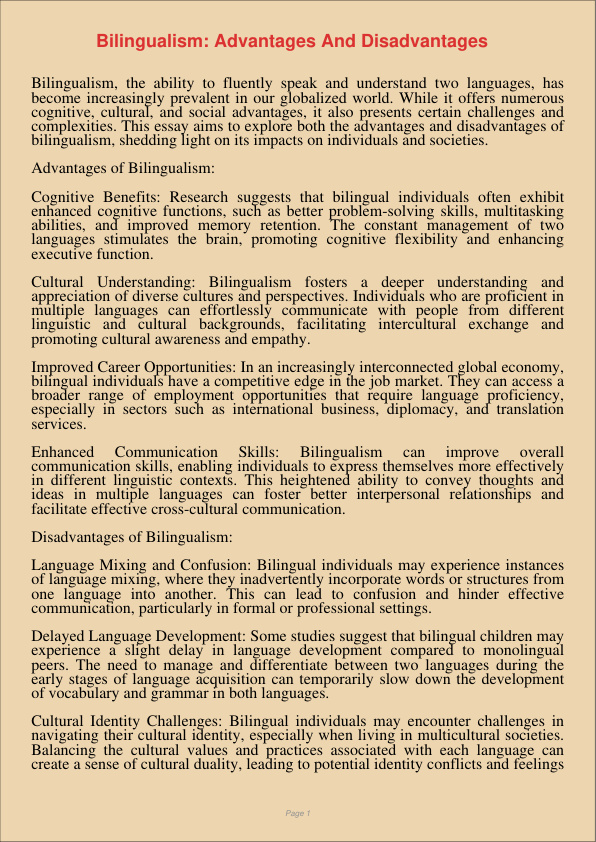Bilingualism Advantages And Disadvantages
Jan 12, 2024
disadvantages
bilingualism
Health Sciences & Medicine
Social science

Bilingualism, the ability to fluently speak and understand two languages, has become increasingly prevalent in our globalized world. While it offers numerous cognitive, cultural, and social advantages, it also presents certain challenges and complexities. This essay aims to explore both the advantages and disadvantages of bilingualism, shedding light on its impacts on individuals and societies.
Advantages of Bilingualism:
Cognitive Benefits: Research suggests that bilingual individuals often exhibit enhanced cognitive functions, such as better problem-solving skills, multitasking abilities, and improved memory retention. The constant management of two languages stimulates the brain, promoting cognitive flexibility and enhancing executive function.
Cultural Understanding: Bilingualism fosters a deeper understanding and appreciation of diverse cultures and perspectives. Individuals who are proficient in multiple languages can effortlessly communicate with people from different linguistic and cultural backgrounds, facilitating intercultural exchange and promoting cultural awareness and empathy.
Improved Career Opportunities: In an increasingly interconnected global economy, bilingual individuals have a competitive edge in the job market. They can access a broader range of employment opportunities that require language proficiency, especially in sectors such as international business, diplomacy, and translation services.
Enhanced Communication Skills: Bilingualism can improve overall communication skills, enabling individuals to express themselves more effectively in different linguistic contexts. This heightened ability to convey thoughts and ideas in multiple languages can foster better interpersonal relationships and facilitate effective cross-cultural communication.
Disadvantages of Bilingualism:
Language Mixing and Confusion: Bilingual individuals may experience instances of language mixing, where they inadvertently incorporate words or structures from one language into another. This can lead to confusion and hinder effective communication, particularly in formal or professional settings.
Delayed Language Development: Some studies suggest that bilingual children may experience a slight delay in language development compared to monolingual peers. The need to manage and differentiate between two languages during the early stages of language acquisition can temporarily slow down the development of vocabulary and grammar in both languages.
Cultural Identity Challenges: Bilingual individuals may encounter challenges in navigating their cultural identity, especially when living in multicultural societies. Balancing the cultural values and practices associated with each language can create a sense of cultural duality, leading to potential identity conflicts and feelings of displacement.
Increased Cognitive Load: Juggling two languages can sometimes impose a higher cognitive load on bilingual individuals, especially when switching between languages in different contexts. This increased cognitive demand may result in mental fatigue and reduced cognitive efficiency in certain tasks.
In conclusion, while bilingualism offers numerous cognitive, cultural, and professional advantages, it also presents challenges that individuals must navigate. Understanding the complex interplay between language proficiency, cognitive processes, and cultural identity is crucial in fostering a supportive environment for bilingual individuals to thrive and contribute positively to a diverse and interconnected global society. Efforts to promote bilingual education, cultural exchange, and inclusive language policies can help maximize the benefits of bilingualism while minimizing its potential challenges.